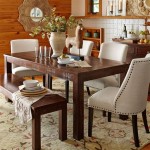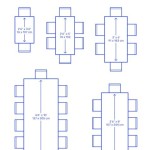Decorating The Dining Room Table
The dining room table serves as a central gathering point in many homes. It is a space for meals, conversations, and often, celebrations. Therefore, decorating the dining room table goes beyond mere aesthetics; it involves creating an inviting and functional atmosphere that complements the room's overall style and enhances the dining experience. A well-decorated table can transform a simple meal into a more memorable occasion, contributing to a sense of warmth and connection among those gathered around it.
Effective table decoration considers several factors, including the size and shape of the table, the existing décor of the dining room, and the purpose of the decoration. Is it for everyday use, a casual gathering, or a formal dinner party? Each scenario calls for a different approach, utilizing various elements like table linens, centerpieces, tableware, and lighting to achieve the desired effect. Furthermore, seasonal changes and personal preferences can influence the decorative choices, allowing for a dynamic and ever-evolving display.
The goal of table decoration is not simply to fill the space but to create a visually appealing and practical setting that contributes to a positive and enjoyable dining experience. Understanding the principles of design and employing them thoughtfully can elevate the dining room from a functional space to a focal point of the home.
Selecting the Right Table Linens
Table linens serve as the foundation for decorating the dining room table. They not only protect the table surface but also contribute significantly to the overall aesthetic. The choice of tablecloth, placemats, table runners, and napkins should be carefully considered based on the occasion and the desired level of formality. For example, a crisp linen tablecloth might be ideal for a formal dinner, while a more casual cotton or linen runner could be suitable for everyday use.
When selecting a tablecloth, it is crucial to consider the size and shape of the table. The tablecloth should drape evenly on all sides, typically with a drop of around 10-12 inches. Avoid tablecloths that are too short, as they can appear skimpy, or too long, as they can be cumbersome and pose a tripping hazard. For round or oval tables, round or oval tablecloths are typically the most aesthetically pleasing choice. Square or rectangular tables can accommodate either square/rectangular cloths or round cloths for a contrasting look.
Placemats and table runners offer an alternative to a full tablecloth, allowing the natural beauty of the table to show through. Placemats define individual place settings and protect the table from spills and scratches. They come in a variety of materials, including fabric, cork, bamboo, and vinyl. Table runners, on the other hand, run down the center of the table, adding a visual element and providing a grounding point for a centerpiece. They can be used alone or in conjunction with placemats.
Napkins are an essential part of any table setting, both functional and decorative. They can be made from a variety of fabrics, including linen, cotton, and paper. Cloth napkins add a touch of elegance to a formal setting, while paper napkins are a convenient option for casual gatherings. The color and pattern of the napkins should complement the overall table setting, either matching or contrasting with the tablecloth or placemats.
Beyond the material and size, color plays a significant role in selecting table linens. Light colors, such as white, cream, and pastel shades, create a sense of spaciousness and airiness. Darker colors, such as navy, burgundy, and forest green, add richness and depth. The choice of color should be based on the overall color scheme of the dining room and the desired mood. Patterns, such as stripes, florals, and geometric designs, can add visual interest but should be used sparingly to avoid overwhelming the table setting.
Creating a Captivating Centerpiece
The centerpiece is the focal point of the dining room table decoration. It draws the eye and sets the tone for the entire table setting. A well-chosen centerpiece should be visually appealing, proportionate to the size of the table, and not obstruct the view of guests seated around the table. The possibilities for centerpieces are virtually endless, ranging from simple floral arrangements to elaborate sculptural displays.
Floral arrangements are a classic choice for centerpieces, bringing a touch of nature and freshness to the table. Consider the size, shape, and color of the flowers to complement the overall table setting. Low, wide arrangements are ideal for allowing conversation to flow freely, while taller arrangements can add drama and visual height. Seasonal flowers can be used to reflect the time of year, such as tulips in the spring, sunflowers in the summer, and berries and foliage in the fall. The container in which the flowers are displayed is also important, as it should complement the flowers and the overall style of the table.
In addition to floral arrangements, other objects can be used to create interesting and unique centerpieces. Candles, either alone or in combination with other elements, can create a warm and inviting atmosphere. Varying the height and style of the candles can add visual interest. Consider using unscented candles, especially during meals, to avoid interfering with the aroma of the food.
Fruit and vegetable displays can also make for a striking and unexpected centerpiece. A bowl filled with colorful citrus fruits, a collection of gourds and pumpkins, or a rustic wooden crate overflowing with fresh herbs can add a touch of natural beauty to the table. These displays can be particularly effective for casual gatherings or seasonal celebrations.
For a more modern and minimalist approach, consider using sculptural objects as centerpieces. A collection of interesting rocks, a piece of driftwood, or a geometric sculpture can add a touch of sophistication and visual interest to the table. The key is to choose objects that are visually appealing and complement the overall style of the dining room.
When creating a centerpiece, it’s important to consider the scale and proportion of the table. A large table can accommodate a more substantial centerpiece, while a smaller table requires a more scaled-down approach. Avoid overcrowding the table with too many elements, as this can make the setting feel cluttered and overwhelming. Simplicity is often key, allowing the centerpiece to stand out without dominating the space.
Selecting Appropriate Tableware and Serving Pieces
The choice of tableware and serving pieces plays a crucial role in completing the dining room table decoration. The style, color, and material of the dishes, glasses, and cutlery should complement the overall aesthetic of the table setting and the type of meal being served. From casual ceramic dishes to elegant porcelain sets, the options are vast and varied.
For formal dinners, a complete set of china, including dinner plates, salad plates, soup bowls, and dessert plates, is typically appropriate. The dishes should be coordinated in terms of color and design, and the cutlery should be made of high-quality stainless steel or silver. Crystal glasses are a classic choice for formal occasions, adding a touch of elegance and sparkle to the table.
For casual gatherings, more relaxed and informal tableware is suitable. Ceramic dishes in bright colors or rustic patterns can create a welcoming and inviting atmosphere. Simple glassware and stainless steel cutlery are appropriate for everyday use. Consider using melamine dishes for outdoor dining, as they are durable and resistant to breakage.
Serving pieces, such as platters, bowls, and serving spoons, are essential for presenting food in an attractive and organized manner. The style of the serving pieces should complement the tableware and the overall table setting. Choose serving pieces that are appropriately sized for the dishes being served, and arrange them strategically on the table for easy access.
When selecting tableware and serving pieces, consider the color and design of the existing décor in the dining room. The dishes, glasses, and cutlery should complement the overall color scheme and style of the room. Neutral colors, such as white, cream, and gray, are versatile and can be easily paired with a variety of other colors and patterns. Bold colors and patterns can add visual interest but should be used sparingly to avoid overwhelming the table setting.
The arrangement of tableware is also important. Proper placement of dishes, glasses, and cutlery is essential for both functionality and visual appeal. Follow basic etiquette guidelines when setting the table, placing the forks to the left of the plate, the knives to the right, and the spoons to the right of the knives. Arrange the glasses in order of use, with the water glass placed above the knife and the wine glasses placed to the right of the water glass. Napkins can be placed to the left of the forks or on top of the plate.
In addition to the basic tableware and serving pieces, consider adding decorative accents, such as place card holders, salt and pepper shakers, and bread baskets. These small details can enhance the overall table setting and add a touch of personality. Choose accents that complement the overall style of the table and the occasion.

Cozy Christmas Dining Room Decorating Ideas Sanctuary Home Decor

16 Modern Dining Table Centerpieces You Can Use Year Round

8 Décor Tips For Your Dining Table Everyday Classic Casual Home

Modern Transitional Dining Room Decor Taryn Whiteaker Designs

10 Formal Dining Room Ideas From Top Designers

Oh So Pretty Spring Dining Room Decorating Ideas Worthing Court

Spring Dining Room Decorating Citrineliving
:strip_icc()/dining-room-table-decor-ideas-1-ashley-montgomery-design-the-nesbit-ef78d3dec9564a2eace6010270f75fa3.png?strip=all)
33 Standout Dining Table Decor Ideas

Dining Room Decorating Ideas On A Budget Glam Modern Neutral

Christmas Dining Room Decorating With Simple And Classic Touches








